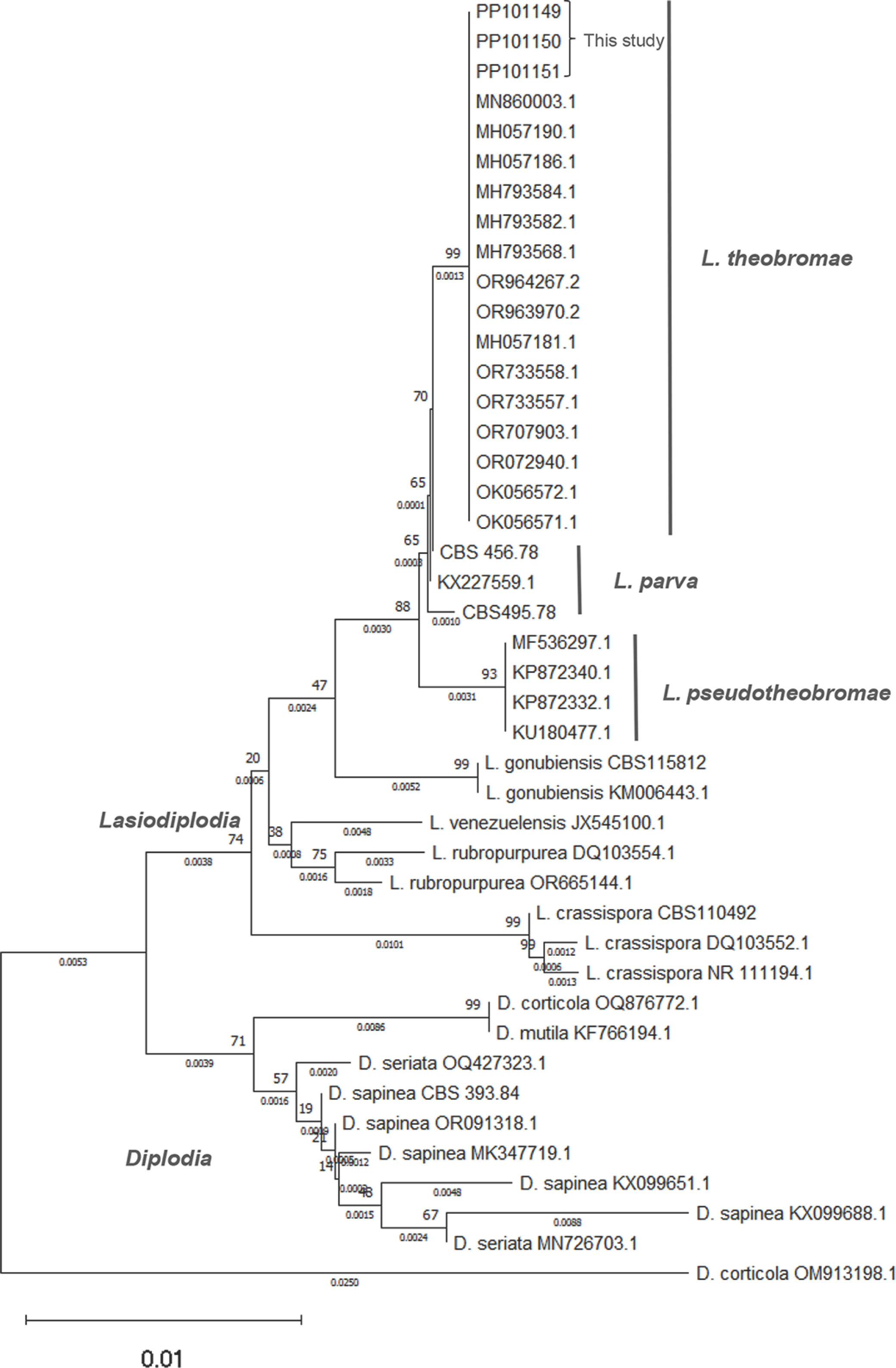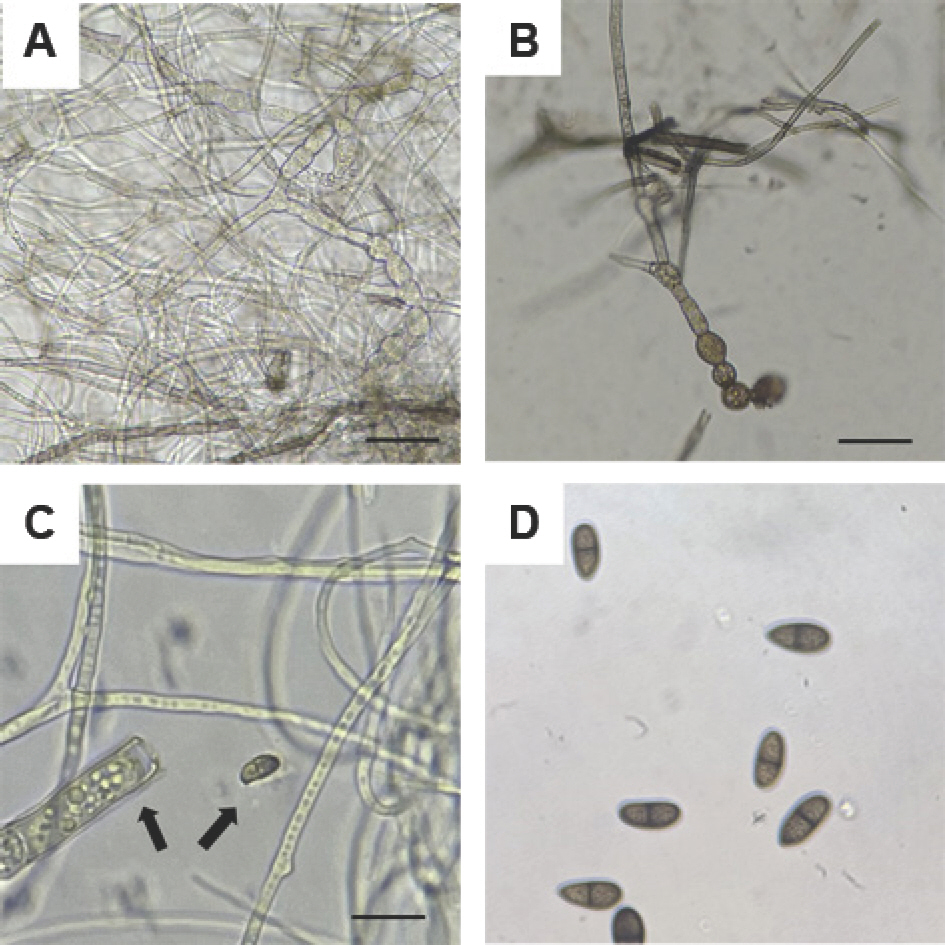The Gummosis disease has inflicted severe damage upon Thanh Tra pomelo trees (
Citrus grandis (L.) Osbeck) in Vietnam, particularly in Thua Thien Hue province, where the cultivation area of this fruit tree currently spans over 1,114 hectares, and the afflicted area were more than 20% (260 hectares) in 2023. The primary objective of this research was to investigate and determine the fungal pathogen responsible for inducing gummosis disease in Thanh Tra pomelo trees. In this study, samples exhibiting symptoms of gummosis were gathered from Thanh Tra pomelo trees within Thua Thien Hue province. To obtain a purified culture of the infected pathogens, the collected samples underwent sterilization using 70% ethanol, being immersed for 1 min and subsequently rinsed three times with sterilized distilled water. Following sterilization, segments of the infected plant containing both the affected and healthy portions, approximately 1-2 cm in length, were placed onto petri plates containing a water agar medium. These plates were then incubated at 28°C for a duration of 5 days. Following the growth of fungal mycelium, three representative mycelium samples were transferred onto new petri plates containing potato dextrose agar (PDA) (
Munirah et al., 2017). Mycelia were then cultured in liquid potato dextrose broth medium at 30°C for 5 days and collected by filtering through Whatman paper. Genomic DNA was isolated using a commercial plant DNA extraction kit (ABT, Hanoi, Vietnam). Molecular identification was performed using primer pairs ITS5 and ITS4, which specifically amplified the internal transcribed spacer (ITS) region of the rDNA of fungi (
Innis et al., 1990). Polymerase chain reaction amplicons were sequenced and searched for homology identification on the GeneBank (the National Center for Biotechnology Information [NCBI] database) using the BLAST tool. The result showed that those our three sequences (accession nos. PP101149 to PP101151) revealed 100% identity with the ITS sequence of
L. theobromae strains ELS4, BRIP64718, and COUFAL520 (accession nos. MN860003.1, MH057190.1, and OR733558.1, respectively). We offer a comparative analysis of the genetic distances among strains belonging to the identical strains, neighboring species (which do not induce gum disease symptoms in pomelo), and certain species within the Diplodia genus, a genus exhibiting a close genetic affinity to the Laiodiplodia genus. Our aim is to demonstrate that despite possessing analogous genetic traits, they do not necessarily serve as the sole determinants for the disease phenotype (
Fig. 1). Initially, the colonies were whitish-grey with abundant aerial mycelial, and gradually turned blackish-grey after 5-7 days on PDA medium at 30°C, but they released red pigment on the medium at 40°C. In this study, the effects of culture media, temperature, and pH were evaluated. PDA were suitable for the growth of fungal pathogens. Temperature and pH values for the growth ranged from 25-40°C and 5-8, respectively. There was no growth at 45°C and the minimum growth was observed at pH 4. Hyphals were hyaline, septate, cylindrical-shaped, and sometimes branched. Conidia were formed in the pycnidia and were ellipsoidal-shaped with a rounded apex and widest in the middle. Immature conidia were colorless, hyaline, and aseptate, while mature conidia were dark brown with black pigment, longitudinally striated, and contained one septum (
Fig. 2). Koch's postulates were performed on stem Thanh Tra pomelo to confirm the pathogenicity of the isolated strains. Briefly, a precise mechanical incision is created on a stem devoid of disease using a sterile, sharp blade. Subsequently, the pathogenic fungus responsible for the disease is applied onto the incision site, after which the area is carefully wrapped or covered. After 4 weeks of
in vivo inoculation, gummosis symptoms were observed in the wound, and the pathogen was re-isolated from the stems of the test plants to fulfill Koch's postulates (
Fig. 3) (
Khanzada et al., 2004).
Based on the results of this study, we identified
Lasiodiplodia theobromae as the causative agent of gummosis disease on the Thanh Tra pomelo trees. Symptoms and morphology of gummosis disease caused by this species are no different from those caused by
Phytophthora spp. on
Citrus spp. (
Dwiastuti and Aji., 2021). The disease usually thrives in the dry season following an extended period of cool temperatures and elevated humidity. When the sun rose, gummosis was oozing sap from small cracks in the bark. The disease makes the tree look like it is bleeding, and lesions usually occur on the main trunk or major branches. The bark stays firm, dries, and eventually cracks and sloughs off. Lesions slowly spread around the circumference of the trunk, girdling the tree. Decline may occur rapidly within a year. To our knowledge, this is the first report on
L. theobromae causing gummosis on Thanh Tra pomelo in Thua Thien Hue Province, Vietnam. According to previous reports,
Phytophthora spp. were the predominant pathogenic genus within Thua Thien Hue province (
Pham et al., 2015). These findings underscore the pathogenicity of
L. theobromae toward Thanh Tra pomelo in Vietnam. The insights derived from this study offer valuable information to aid plant disease management organizations in enhancing the efficacy of disease control measures specifically targeted at Thanh Tra pomelo.










